In October, my husband Kevin and I attended a mushing training weekend organized by the Maine Highlands Sled Dog Club.
“Mushing Basics and Beyond” is a great opportunity for newbies to learn basic mushing skills and for experienced mushers to reinforce skills with their dog team. Kevin has summarized the weekend activities in the following Guest Blog Post.
Mushing Basics and Beyond
The guy who taught me how to play golf many years ago (right after the end of the Civil War) was a font of common sense. He once said to me: “You know, if you don’t have a target in mind and aim at it, the only way the ball is going to end up there is by accident.”
Actually it’s even worse than that. The only way the ball is going to end up going toward the target is if you screw up your swing by exactly the same amount as you’ve screwed up your aim. So, the moral is: take careful aim. It is a basic principle of golf.
For the past three days we have been attending a course at the Maine Highlands Sled Dog Club entitled “Mushing Basics and Beyond”. The participants are mushers with a variety of experience. What they all have in common is they want to learn. They realize that no matter how many miles you’ve run with a dog sled team, you’re never so experienced that you have nothing new to learn. They all appreciate the fact that, if you get the basics wrong, your problems seem to grow exponentially.
So, what are the basics of mushing? Well, I’ve been through a number of these courses with the Head Musher and, even though I’m a golfer not a musher, certain things sink in.
How about this one: If your dog has an ill-fitting harness, he won’t pull efficiently. If it’s really ill-fitting it will impair his ability to breathe while running and could cause injury.
The very first session was devoted to a discussion of how to make sure each of the dogs on your team has a harness that fits properly. We all gather in the garage and watch a dog being fitted for a harness. I’m always impressed with how patient the guinea-pig dog is during these kinds of sessions.
It’s a pretty basic thing yet you see dogs at races with ill-fitting harnesses. An experienced musher can look at a dog and tell immediately whether the harness fits correctly. I guess that’s not any different than a good golfer looking at another golfer’s hands on the golf club and concluding that the guy probably spends a lot of time in the trees looking for balls.
After the classroom instruction, the harness checking continues out on the trail where you can see the dogs in action.
Speaking of the trail, there are five “Confidence Runs” during the weekend. The objectives, once again, are simple and basic i.e., make sure the dogs are able to pass other teams from behind without incident; train lead dogs to obey simple, but critical, commands; train dogs to pass other teams head-on without incident. The word “incident” in the previous sentences means everything from sniffing, interacting with, getting tangled with, or fighting with other dogs.
So here’s what happens in the first “Confidence Run”. First, everybody is assigned a bib number just like in a race. There are twelve teams so twelve bibs are assigned. The teams then exit the yard and head onto the trail according to bib number. The first team goes far enough down the trail so that all twelve teams will fit behind him. When they are all in a line on the far right side of the trail, the last team passes the other eleven teams and moves to the head of the line. This happens on a trail that in some places is barely wide enough for two teams. And here’s the catch – the passing team is required to pass as slowly as possible so that the dogs are beside the other teams for as long as possible. If a dog is going to misbehave, this will flush the problem out into the open.
Then the eleventh team does the same thing. Then the tenth, and so on, until the teams are in reverse order. Then it starts over again. This goes on for several miles.
So, you ask, what do you do if the dogs misbehave? How does the musher correct them if the musher is riding the cart? Here’s a picture that explains it…
The musher isn’t riding the cart. The musher is busy enforcing the “no bothering the other team rule”. That’s the Head Musher praising the team just after a six dog team passed without incident.
So who is riding the cart? This is the really alarming part — they have entrusted the One-Man Pit Crew with driving responsibilities. Evidently they have already forgotten about last year!
The instructions are pretty simple: don’t go too fast; stay on the right side of the trail when parked; stay on the left side of the trail when passing; don’t run over a dog or person; and most importantly don’t, under any circumstances, let go of the cart. A cart without a rider is like a loose cannon on the deck of a ship. I followed instructions and I only got the “slow down” sign once or twice from the Head Musher. At least I think that’s what the sign was.
I also got dragooned into riding the cart for the head-on passing drills, which have a much greater probability of resulting in disaster. Dog teams have this alarming tendency of running directly at each other and then veering off in an avoidance maneuver at the very last second – at least most of the time they veer off. If they don’t, you end up with eight to twelve dogs in a mad tangle growling at each other. In a really bad tangle, the lines have to be cut. You don’t want bad tangles.
Here I am on the cart, both hands on the brakes, pretending to be in control of my fate. That’s the Head Mushers with the white bib barking out commands to the dogs.
The Head Musher resumed command of the cart for the nighttime leader training run. They turn all teams loose in a maze of paths cut through a grassy field and the teams make a series of left and right turns sometimes while passing each other head-on.
Here’s the Head Musher with her two leaders (Aura and Cree) hanging a “gee” (a right turn) in the field. The dogs, of course, have no trouble seeing in the dark. In fact they seem to work better in the dark. Humans, on the other hand, wear headlamps and spend most of the time with their pupils alternating between being dilated and constricted to pin-head size because of the glare from head-lamps.
The training session ended on the final day with a “mock race” the purpose of which was to put all the learned skills to the ultimate test. The teams went out at two minute intervals as they would in a real race. The course was out and back for a total of three miles.
Here’s a picture of the Head Musher about forty yards after she left the starting gate. All appears to be going well. What isn’t obvious is that Chinook, the middle dog running alone, broke his tug line as he pulled away from the starting line. The tug line is the line that hitches the back of the dog’s harness to the main line pulling the sled. The Head Musher had to secure the sled, jump off, and jury-rig a temporary fix before the next team launched from the starting line. Here she is cruising down the trail as if nothing has happened.
Here she is returning three miles or so later with team three in hot pursuit…
The white dog on the left in lead is our new dog. Did I mention that we now have five dogs? Must’ve slipped my mind. Evidently, I let my guard down and the Head Musher acquired another dog. Her name is Cree, a white Siberian Husky. She’s a veteran lead dog from Kasey McCarty’s kennel. Kasey runs 100-mile plus races and Cree has been her leader for some of them.
Here is the Dog Whisperer (aka the Head Musher) sweet-talking Cree into joining the team…
She’s a pretty dog with a great temperament. What’s not to like about this dog?
When I was riding the cart, she gave me her “Who’s in charge?” look. And I gave her back my “Well, don’t look at me” look.
So, here’s this year’s team, affectionately known as the “Fab Five”. That’s Fenway in the front, turning his head because he knows I’m trying to take his picture. Next, that’s Kodiak still snubbing me because I stayed behind in Maryland for four weeks and played golf. Next is Aura, and then Cree and Chinook. A pretty good looking group, if I do say so myself.
We are now back home and Cree is transitioning from kennel dog to house dog. Aura has taught her how to go up and down stairs and the self-proclaimed sergeant at arms i.e., Chinook
…has barked at her for venturing into the kitchen unescorted. The world is spinning in greased grooves.
Our next trip is scheduled for the weekend of 8 November. It’s the annual musher’s reunion in State College Pennsylvania.
Later,
The One-Man Pit Crew
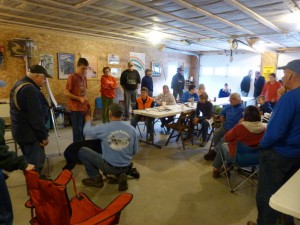
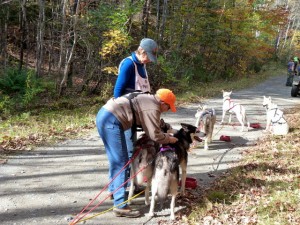

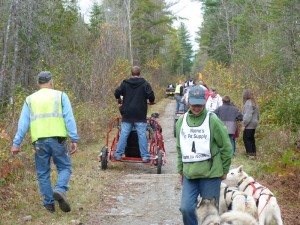
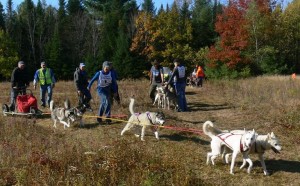
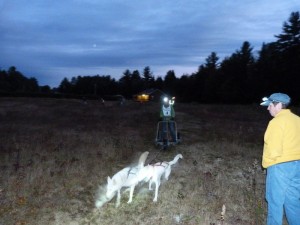
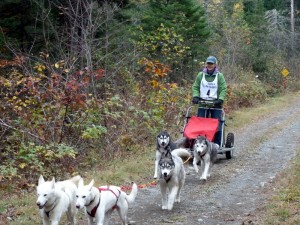
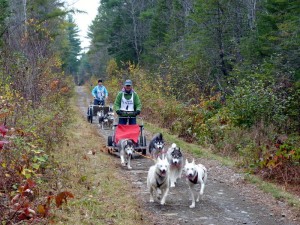

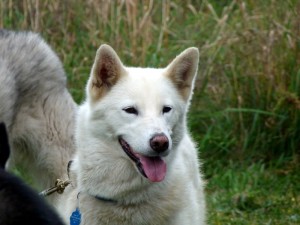
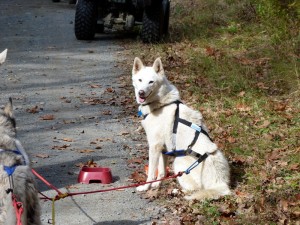
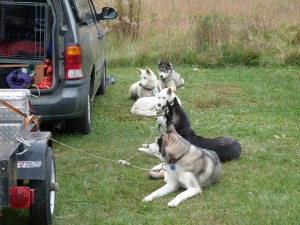
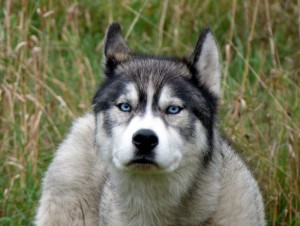
Very observant Kevin. I wouldn’t be surprised to see you with your own team next year!!! When are you going to write a book?